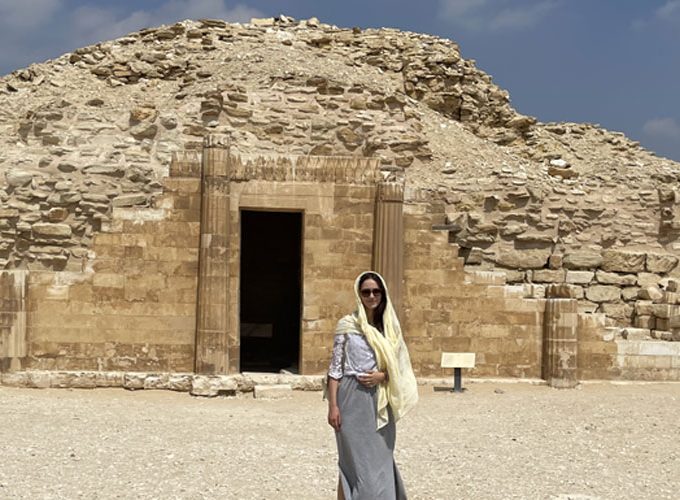In fact, Embarking on a journey to the awe-inspiring Giza Pyramids, Sphinx, Sakkara, and Dahshur is not merely a trip. It’s a profound encounter with human history and architectural marvels that have stood the test of time. This adventure will inspire you to reach new heights in your own life. Just as these ancient wonders have done for centuries. Enjoy Tour to Giza Pyramids, sphinx, Sakkara & Dahshur.
ال Giza pyramid complex (also called the Giza necropolis) in Egypt is home to the Great Pyramid, the Pyramid of Khafre, and the Pyramid of Menkaure, along with their associated pyramid complexes and the أبو الهول العظيم. All were built during the Fourth Dynasty of the Old Kingdom of مصر القديمة, between c. 2600 – c. 2500 BC. The site also includes several temples, cemeteries, and the remains of a workers’ village.
أ tour to the Giza Pyramids, the Great Sphinx, Sakkara, and Dahshur is a journey through the very heart of ancient Egypt’s history, revealing the architectural brilliance and spiritual beliefs of one of the world’s greatest civilizations. These sites, each with its own unique significance, tell the story of the evolution of pyramid construction, from the earliest stepped structures to the perfectly smooth pyramids of Giza. As visitors travel from one site to another, they retrace the footsteps of the ancient Egyptians who built these wonders over 4,500 years ago.
The tour begins at the Giza Pyramids, the most famous and enduring symbols of Egypt’s ancient past. The Great Pyramid of Khufu (Cheops), the largest and most impressive of the three, was built during the Fourth Dynasty around 2580 BCE and originally stood at 146.6 meters (481 feet) before erosion and the removal of its outer casing reduced its height slightly. Constructed from over 2.3 million limestone blocks, some weighing as much as 15 tons, this pyramid is a testament to the ingenuity and engineering skills of ancient Egyptian architects. Despite centuries of study, the precise methods used to build this colossal monument remain a mystery, with theories ranging from massive ramps to sophisticated counterweight systems. Adjacent to it, the Pyramid of Khafre (Chephren) appears taller due to its placement on higher ground, though it is slightly smaller than Khufu’s. Unlike the Great Pyramid, Khafre’s retains some of its original casing stones at the summit, offering a glimpse of how these pyramids once gleamed under the sun. The third and smallest of the trio, the Pyramid of Menkaure (Mykerinos), though less imposing in size, is known for its use of granite in the lower sections, hinting at an evolution in pyramid construction techniques.
Guarding these monumental tombs is the أبو الهول العظيم, a colossal limestone statue with the body of a lion and the head of a pharaoh, believed by many to represent King Khafre. The Sphinx, measuring approximately 73 meters (240 feet) in length and 20 meters (66 feet) in height, has stood watch over the Giza Plateau for thousands of years, enduring wind, sand, and time itself. Scholars believe it was carved from a single limestone outcrop, though its exact purpose remains debated—some suggest it served as a guardian of the necropolis, while others propose it symbolized the merging of human intelligence and lion-like strength. Over the centuries, the Sphinx has undergone restoration efforts, particularly due to erosion and damage to its face, including the loss of its nose, which has fueled numerous myths about its destruction.
Leaving Giza behind, the journey continues south to Sakkara, the vast necropolis of ancient Memphis and home to the earliest known pyramid: the Step Pyramid of Djoser. Built during the 27th century BCE by the visionary architect Imhotep, this pyramid marked a revolutionary departure from traditional mastaba tombs, stacking six layers to form a step-like structure. Standing at approximately 60 meters (197 feet), the Step Pyramid was part of a larger funerary complex, including courtyards, temples, and a massive stone wall that encircled the site. Sakkara, however, is not just about Djoser’s pyramid—it is a treasure trove of ancient tombs, decorated with vivid hieroglyphs and scenes of daily life, showcasing the artistry and beliefs of ancient Egyptian society. The site also includes the Tomb of Mereruka, one of the most beautifully preserved mastabas, depicting scenes of fishing, farming, and rituals, providing invaluable insight into the lives of noblemen and officials.
Further south lies Dahshur, a lesser-visited yet historically significant pyramid field that played a crucial role in the evolution of pyramid design. It was here that Pharaoh Sneferu, father of Khufu, experimented with pyramid construction, leading to two of Egypt’s most fascinating structures. The Bent Pyramid, so named for its sudden change in angle halfway up, is an architectural anomaly that reveals the challenges faced by early builders as they sought to perfect the true pyramid shape. Scholars believe that engineers altered its angle from 54 to 43 degrees to prevent collapse, making it a crucial learning step in the development of later pyramids. Nearby, the Red Pyramid, also built by Sneferu, stands as the first successful attempt at a smooth-sided pyramid, its reddish limestone giving it a distinctive appearance. Unlike the pyramids at Giza, visitors can enter the Red Pyramid and explore its burial chambers, gaining a rare firsthand experience of the interior of an ancient pyramid.
Together, these sites—Giza, Sphinx, Sakkara, and Dahshur—offer a complete narrative of pyramid construction, from its earliest forms to its most refined expressions. They reflect not only the ambition and ingenuity of the pharaohs but also the deeply ingrained religious beliefs that drove their construction. The pyramids were not merely tombs; they were grand stairways to the heavens, ensuring the eternal journey of the kings who built them. Visiting these ancient wonders is like stepping back in time, experiencing firsthand the awe and mystery that have captivated historians, archaeologists, and travelers for centuries.


